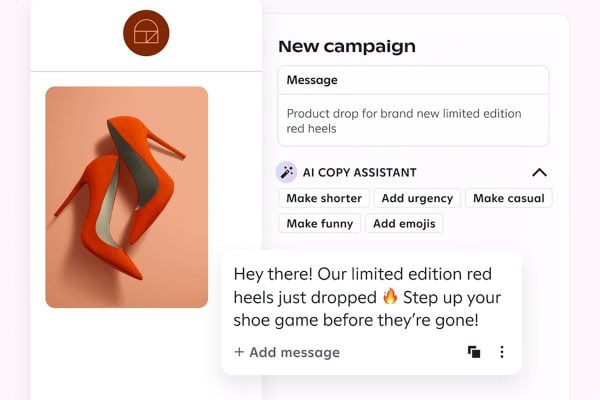 Johan Boström, co-founder and CPO at inriver takes a look at shoppers’ attitudes and how they are are changing loyalties from brand to marketplaces. It’s all very well having the best brand in the world, but Johan argues that sales enablement on marketplaces is just as important as the inherent brand value:
Johan Boström, co-founder and CPO at inriver takes a look at shoppers’ attitudes and how they are are changing loyalties from brand to marketplaces. It’s all very well having the best brand in the world, but Johan argues that sales enablement on marketplaces is just as important as the inherent brand value:
Changing loyalties from brand to marketplaces: Shoppers’ attitudes and what they want at their fingertips
Companies spend millions on branding. Building reputations, unique experiences, differentiators that make them stand out from the crowd. There is a lot of value in a branding, indeed, Forbes famously publishes its World’s Most Valuable Brands each year, with the top spots commanding eye-watering figures that roll into the hundreds of billions. But it’s not the logo that drives these valuations. It’s their market success. It’s sales and steering the market direction through sheer volume. Having a presence that people can’t help but sit up and pay attention to.
In the world of consumer goods, “branding” then must therefore come second to sales enablement. Or rather, sales enablement is vital to brand success. One without the other is at best a losing battle, at worst a vanity project.
What is clear is that the value and discussion around branding has moved on. However, as we head into 2022 what does this mean for retailers and ecommerce sellers? What do they need to do in order to ensure their reach customers effectively to drive sales?
Finding where the value lies – marketplaces
The good news is, we recently conducted some research amongst consumers and found that marketplaces command the largest portion of initial product (re)search. Not Google, not peer reviews, and certainly not brand websites – marketplaces.
What this shows us is a shift in digital commerce. The starting point for any product search or customer journey is not a brand website, commanding only 9% of initial searches. It is now the likes of Amazon and eBay with 44%. This means that consumers have more affinity and loyalty to a marketplace than a specific brand. This shift in affinity needs to be reflected within a brand. Retailers need to ensure they have the right focus of marketing spend on marketplaces to ensure their brand is seen by their customers.
It is not just spend however that needs to be looked at. There are a number of things that retailers and e-commerce brands need to proactively do to ensure they stand out on marketplaces.
Getting your digital stall pitch perfect
Marketplaces can be fiercely competitive. If I type in “headphones” on Amazon right now I get over three-thousand results to choose from. It’s a staggering wealth of choice. What this means is your digital stall really needs to be pitch perfect, and findable in the first place.
First up is the experience must meet expectations: not just branding, but what it says. The fact is, almost two-thirds of shoppers in the research we conducted decided against buying simply due to poor product descriptions. What further complicates this is the need for consistency across all channels – eBay, JD, Alibaba, and retailers like Tesco, Walmart, Target, and so forth.
Yes, shoppers are starting (and many ending) on marketplaces, but 4 in 5 will visit more than one location for information on your product, even if they already have everything you think they need. So, while the focus should be on marketplaces, retailers shouldn’t put all their eggs into one basket. And for those that are considering scaling across new channels, make sure to pay each and every one the attention they need to keep it consistently pitch-perfect. The challenge really is when you factor in the 20 or so touchpoints of your customer journey, multiply it by the potential breadth of sales channels, and your full online product portfolio. Managing brand experience can quickly seem intimidating and impossible to scale.
Even simple tasks like stock availability, management, and delivery get messy. But simply said: if it’s not there, it can’t be bought. Brand loyalty isn’t what it was, with the same research finding that two-thirds of shoppers will simply switch to the next best thing if the brand they were after is out of stock – with similar figures for if they can’t find the product, too.
Incremental opportunity
It’s not all doom and gloom. Most consumer product brands struggle with this in one way or another – and they’re probably still doing OK. What this really means is, the opportunity with marketplaces is big. There is an opportunity to find incremental gains at scale as you bring product portfolios, markets, and entire geographies up to scratch at an achievable, and noticeable rate.
But whether you’re a large multinational like Unilever or Nestle, or a local brew beer maker, retail has been and always will remain a margins and volume game. Players of every size cannot afford to miss out on purchase influencing tactics such as these.
That’s why product information management (PIM) and digital shelf analytics (the process of both managing and enhancing all of your products’ digital footprints) should sit at the very heart of sales enablement and driving brand value and recognition. This isn’t a job any one person, or even team, can keep up with without help. Fortunately, these types of foundational solutions can help you keep tabs on your channels and proactively address areas that need optimisation. and help deliver a true omnichannel experience for the buyer, without manual work from the brand.
With the right solution in your arsenal, the challenges of consistency, convenience, and availability become manageable. Product managers, channel managers, and e-commerce teams will be more productive, find meaningful insights in customer behaviour, and respond readily to market demands at scale before they impact revenue or disappoint shoppers.
Your brand is only worth as much as the current marketplaces and online channels show. Make sure each one counts.
To learn more about online shopper habits and PIM technology read the latest report from inriver, Inside the mind of an online shopper.









